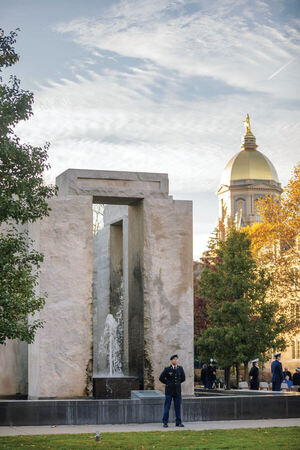
At least 20 lost their lives in military aircraft strikes or crashes during their tours of duty. A similar number were fatally wounded by enemy fire on the ground. Another 11 were declared dead while missing in action or being held as prisoners of war.
A heartbreaking story may be told about each Notre Dame man who died during the Vietnam War. Darrell Katovsich, who has researched these stories, doesn’t want those men or their sacrifices to be forgotten.
Katovsich grew up in South Bend visiting campus as a boy and following Notre Dame football. He graduated from St. Joseph High School and eventually from Purdue University.
Before attending college, Katovsich served in the U.S. Army in Vietnam in 1968-69. Once during that tour of duty he was able to listen to a few minutes of a Fighting Irish football game on the Armed Forces Network. He recalls the announcer saying it was a beautiful fall day in South Bend.
“I had the benefit of having one five-minute exposure to my hometown,” he says. “You have no idea what that means in a war zone.”
In 2017, when Katovsich learned that Notre Dame didn’t have a comprehensive list of alumni who died during the Vietnam War, he volunteered to compile one. He recently finished the project. His report, titled “For God, Country, Notre Dame: Remembering Notre Dame’s Fallen Vietnam War Servicemen,” drew on military records, news reports and obituaries from the period, and the help of the Alumni Association, the University Archives and those classmates of the fallen servicemen who could offer their own recollections. The complete document is posted on The University of Notre Dame Class of 1969 Blog.
Katovsich’s work revealed the toll was much higher than the 32 Notre Dame men previously thought to have died while serving in Vietnam. Through meticulous research, he identified 44 alumni servicemen who died in combat in Vietnam and another 30 who perished in noncombat incidents during the era. The list includes graduates, former students who had transferred to other institutions, and a few who dropped out to enlist in the military or for other reasons.
The names of those who died in combat appear on the Vietnam Veterans Memorial in Washington, D.C.
Twenty-four of the men on Katovsich’s list were serving in the U.S. Army, 18 in the Marines, 17 in the Air Force and 14 in the Navy. One, Michael A. Rosick, 19, a sophomore midshipman in the Naval ROTC program, died in a civilian automobile crash in Buchanan, Michigan, on May 4, 1969, while returning to campus from a battalion picnic.
Notre Dame’s Class of 1968 lost nine members to the war, more than any other class.
For each fallen serviceman, Katovsich wrote a brief biography that includes the full name, hometown, military rank, record of service, military honors and casualty data, whether the body was recovered and burial details. For some, he was able to add personal information such as marital status and whether the serviceman had children.
U.S. Marine Corps Maj. James Thomas Egan Jr. ’64 went missing in action in 1966 and was declared dead 12 years later. His remains were never recovered. A memorial marker in Arlington National Cemetery bears his name.
Lt. Col. Harold Joseph Alwan ’56, a Marine pilot, was on a one-man mission in 1967 when his plane vanished over the South China Sea. There were no witnesses. Alwan was declared dead in 1974 and his body was never recovered.
1st Lt. Kevin Burke ’67 and 1st Lt. Patrick Dixon ’67 were trained in the Army ROTC program at Notre Dame. Burke was killed in action in November 1968 while serving as a platoon leader on a combat sweep operation to rescue wounded and dead soldiers. Six months later, Dixon was leading a unit that encountered machine gun fire and was hit while pushing one of his men out of harm’s way. He, too, died from his injuries.
1st Lt. Robert John Stork Jr. ’64 and 1st Lt. John Rahiya ’66 met just once and only briefly — in April 1969 at Long Binh Army base. The two officers quickly established their Notre Dame connections. “We had planned to get together for a beer and to talk ND,” Rahiya told Katovsich in a 2018 interview, but that night, the enemy launched a rocket attack on the base and struck the living quarters. Stork was killed instantly.
On and on the list goes, each story as poignant as the last.
After a memorial service held near the front steps of the Main Building this past June, honoring the memory of the men who served and died, Katovsich gave a copy of his report to the University Archives as a comprehensive record for future researchers.
All along, he says, he kept in mind that one overriding goal that had inspired him in 2017: “So these guys don’t get forgotten.”
Margaret Fosmoe is an associate editor of this magazine. She can be reached at mfosmoe@nd.edu or @mfosmoe.